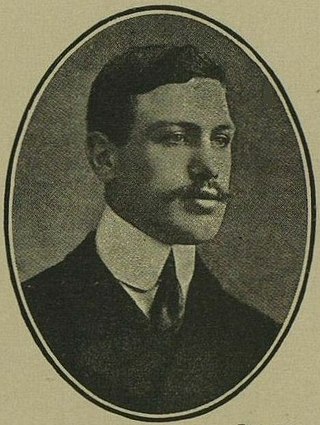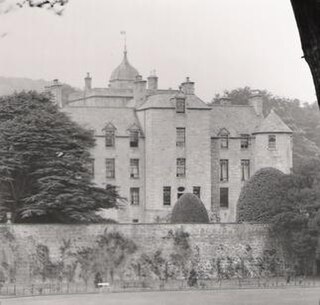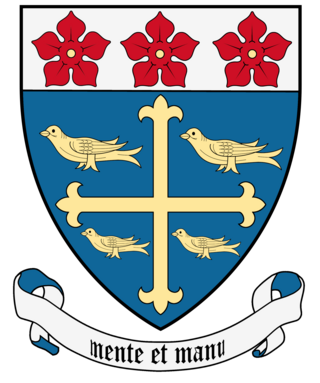
Archibald Philip Primrose, 5th Earl of Rosebery, 1st Earl of Midlothian, was a British Liberal Party politician who served as Prime Minister of the United Kingdom from March 1894 to June 1895. Between the death of his father, in 1851, and the death of his grandfather, the 4th Earl of Rosebery, in 1868, he was known by the courtesy title of Lord Dalmeny.

Queensferry, also called South Queensferry or simply "The Ferry", is a town to the west of Edinburgh, Scotland. Traditionally a royal burgh of West Lothian, it is now administered by the City of Edinburgh Council. It lies ten miles to the north-west of Edinburgh city centre, on the shore of the Firth of Forth between the Forth Bridge, Forth Road Bridge and the Queensferry Crossing. The prefix South serves to distinguish it from North Queensferry, on the opposite shore of the Forth. Both towns derive their name from the ferry service established by Queen Margaret in the 11th century, which continued to operate at the town until 1964, when the Road Bridge was opened.

Mentmore Towers, historically known simply as "Mentmore", is a 19th-century English country house built between 1852 and 1854 for the Rothschild family in the village of Mentmore in Buckinghamshire. Sir Joseph Paxton and his son-in-law, George Henry Stokes, designed the building in the 19th-century revival of late 16th and early 17th-century Elizabethan and Jacobean styles called Jacobethan. The house was designed for the banker and collector of fine art Baron Mayer de Rothschild as a country home, and as a display case for his collection of fine art. The mansion has been described as one of the greatest houses of the Victorian era. Mentmore was inherited by Hannah Primrose, Countess of Rosebery, née Rothschild, and owned by her descendants, the Earls of Rosebery.

Earl of Rosebery is a title in the Peerage of Scotland created in 1703 for Archibald Primrose, 1st Viscount of Rosebery, with remainder to his issue male and female successively. Its name comes from Roseberry Topping, a hill near Archibald's wife's estates in Yorkshire. The current earl is Neil Primrose, 7th Earl of Rosebery.

Dalmeny House is a Gothic revival mansion located in an estate close to Dalmeny on the Firth of Forth, in the north-west of Edinburgh, Scotland. It was designed by William Wilkins, and completed in 1817. Dalmeny House is the home of the Earl and Countess of Rosebery. The house was the first in Scotland to be built in the Tudor Revival style. It provided more comfortable accommodation than the former ancestral residence, Barnbougle Castle, which still stands close by. Dalmeny today remains a private house, although it is open to the public during the summer months. The house is protected as a category A listed building, while the grounds are included in the Inventory of Gardens and Designed Landscapes in Scotland.

Albert Edward Harry Meyer Archibald Primrose, 6th Earl of Rosebery, 2nd Earl of Midlothian,, styled Lord Dalmeny until 1929, was a British liberal politician who briefly served as Secretary of State for Scotland in 1945. He was the Member of Parliament for Midlothian from 1906 to 1910. He became the Earl of Rosebery and Midlothian in 1929 and was thus a member of the House of Lords until his death.
Neil Archibald Primrose, 7th Earl of Rosebery, 3rd Earl of Midlothian, styled Lord Primrose between 1931 and 1974, is a Scottish nobleman. He was a member of the House of Lords from 1974 to 1999. His son and heir is Harry Primrose, Lord Dalmeny.

Inchgarvie or Inch Garvie is a small, uninhabited island in the Firth of Forth. On the rocks around the island sit four caissons that make up the foundations of the Forth Bridge.

Dalmeny is a village and civil parish in Scotland. It is located on the south side of the Firth of Forth, 1 mile (1.6 km) southeast of South Queensferry and 8 miles (13 km) west of Edinburgh city centre. It lies within the traditional boundaries of West Lothian, and falls under the local governance of the City of Edinburgh Council.

Haltoun House, or Hatton House, was a Scottish baronial mansion set in a park, with extensive estates in the vicinity of Ratho, in the west of Edinburgh City Council area, Scotland. It was formerly in Midlothian, and it was extensively photographed by Country Life in September 1911.

Clan Primrose is a Lowland Scottish clan.
Archibald Primrose may refer to:

Craigiehall is a late-17th-century country house, which until 2015 served as the Headquarters of the British Army in Scotland. It is located close to Cramond, around 9 km (5.6 mi) west of central Edinburgh, Scotland.

Hound Point is a marine terminal off a rocky headland of that name on the southern shore of the Firth of Forth, Scotland, just east of the Forth Bridge at South Queensferry. Opened in 1975, it is owned and operated by Ineos as an oil-export terminal for North Sea oil and is the largest such facility in Scotland.

Queensferry High School is a six-year comprehensive school in the town of South Queensferry, Scotland, run by the City of Edinburgh Council. It was opened in 1970 by Princess Margaret marking the 900th anniversary of the arrival of Queen Margaret in Queensferry. Currently it has 1036 students, predominantly from Echline Primary School, Queensferry Primary School, Dalmeny Primary School and Kirkliston Primary School. It was made a School of Ambition in 2007.

Harry Ronald Neil Primrose, Lord Dalmeny, known as Harry Dalmeny, is a British aristocrat and the Chairman of Sotheby's in the United Kingdom. A member of the British aristocracy, he is the heir to ten noble titles, including the earldoms of Rosebery and Midlothian, to the Primrose family estate Dalmeny House, and to the chiefship of Clan Primrose. Dalmeny is a Deputy Lieutenant for the county of Midlothian and is a member of the Royal Company of Archers.

Ochiltree Castle is a 16th-century tower house a few miles south east of Linlithgow in West Lothian, Scotland. It is also described as a farmhouse and lairds house. Along with its boundary wall, the castle was designated as a Category A listed building in 1971.
Sir John Smith of Grothill and Kings Cramond was a 17th-century Scottish landowner and merchant who served as Lord Provost of Edinburgh from 1643 to 1646.

The South Queensferry Tollbooth is a municipal structure in the High Street, South Queensferry, Edinburgh, Scotland. The structure, which served as the meeting place of the Royal Burgh of Queensferry, is a Category A listed building.



















